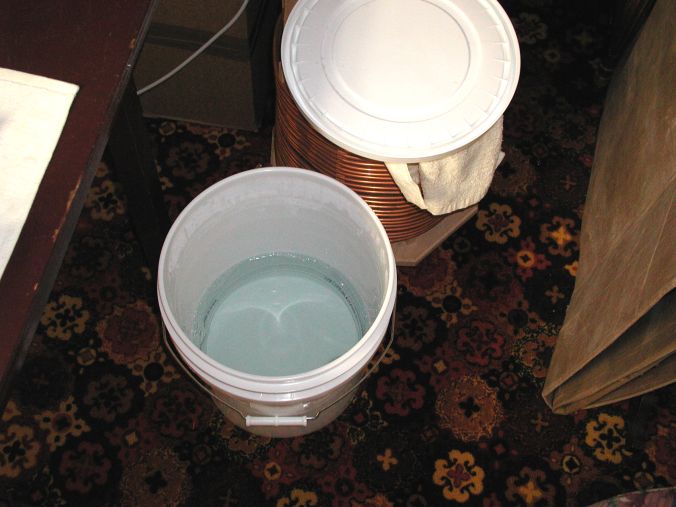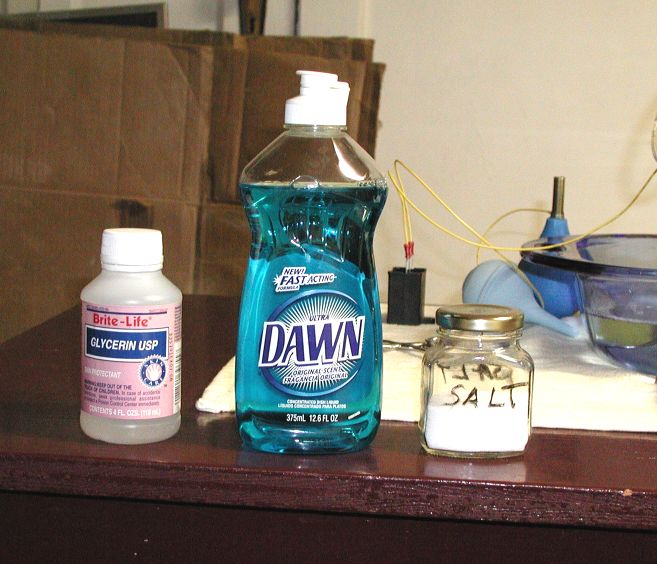
Basics of Antibubbles
Antibubbles... What are they?
An antibubble is simply the rare reverse case of a typical bubble. In a normal bubble, a ball of air is surrounded by a thin film of liquid. An antibubble is a ball of liquid surrounded by a thin film of air.

Here is one about 1 inch in diameter in a large jar of soapy water. They are extraordinarily fun little things that are easy to make.
The "Holy Grail" of how to make them was published in the April 1974 issue of Scientific American in the Amateur Scientist section. J.E. Connett of the University at Northern Illinois sent two letters in that describes them.
Rather than have me report what others already have done, I will simply point you to some great sites with the basic details:
http://www.jtan.com/antibubble/
http://www.eskimo.com/~billb/amateur/antibub/antibub1.html
My work with them...
I have done a great amount of work with antibubbles over the years since I first read the original Scientific American article and I would like to share some of the more advanced things I have learned. I have made them up to about three inches in diameter with some pretty elaborate equipment. It is easy to make small ones as described, but there is some real science that can be applied to making them bigger and reliably. There are four things that are really important to making big antibubbles reliably:
1. Keep It Clean! These fragile little bubbles HATE lint, dirt, and other physical contaminates that tend to breach the thin (~0.0002 inch!) air film. Everything needs to be rinsed and the solutions and equipment need to be protected from dust. We don't need to worry much about chemical and oils, but fiber strands and other objects in the solution will easily "pop" antibubbles. So rinse the dust away and cover the equipment to keep dust down as much as possible. Latter, I will describe filtration systems that make it easy.
2. Think BIG! You can't make a two inch antibubble in a drinking glass. You need gallons of space to work with! If you want to make the big ones, just start collecting some seriously big containers right now. In general, I think you need a container with an opening about five to ten times larger than the bubbles you want to make. Glass is best! Plastic works too but the solutions tend to attack it.
3. The Soap... Make your solution in a big 5 gallon bucket with a lid like this:

This will keep it clean and just make things really easy. Here is the recipe for the solution but feel free to try things. Here are the four ingredients in Terry's Special Antibubble Solution (TSAS). The amounts and such are far from critical.
4 gallons of clean room temperature water. If your water is hard, consider getting distilled water. We want water that makes bubbles like crazy :-))
1 table spoon of salt for electrical conductivity. Use the refined type from the grocery store as opposed to natural rock salt to be sure it is clean.

1 oz of Glycerin. The pharmacy has it. "Glycerin, USP, 99.5% anhydrous" Ask the pharmacist where it is. It is used for a lot of things like skin protectant and in many topical ointments. It is a little pricey at about $1 per oz. The glycerin helps "seal" the antibubble surfaces to greatly reduce "gas transfer" which is a big problem.
2 oz of dish soap. Forget the brand names and all the hype. It is all made buy the same place (Hecho Surfactants of Mexico) that fills railroad tankers with it and sends it to be bottled.... Only the label, color and price are different... Avoid funny smelling ones and colors you don't like. Blue is nice but yellow tends to look very clear. "I" never liked green... Avoid the cloudy ones (Ivory) or ones that may contain odd additives (Palmolive) . You want the nice clear kinds. It is best if you get this new since "old" soap may tend to contaminate and degrade.
Put the ingredients in your bucket and mix them up. Try not to foam it up to make a big mess. Let the solution sit over night so the temperature and dissolved gases will stabilize. If your in a hurry, use it now ;-)
4. Electricity! Ever wonder why sometimes antibubbles are easy to make and other times they are impossible to make? It is electricity. If the forming antibubble and the solution have only 0.3 volt potential difference between them, they will pop! Latter I will explain how to control this so you can always make antibubbles very easily. The salt we add helps this a lot too.